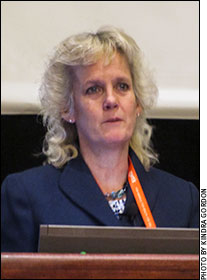Using Genetics to Select for Healthier Cattle
Genetic prediction for resistance to bovine respiratory disease is on the horizon.
 “Genomics allow us to look ‘under the hood’ of an animal so to speak,” said Alison Van Eenennaam with University of California–Davis as she addressed Cattlemen’s College® attendees Feb. 1 at the 2017 Cattle Industry Convention in Nashville, Tenn.
“Genomics allow us to look ‘under the hood’ of an animal so to speak,” said Alison Van Eenennaam with University of California–Davis as she addressed Cattlemen’s College® attendees Feb. 1 at the 2017 Cattle Industry Convention in Nashville, Tenn.
Van Eenennaam provided an overview of the history in DNA sequencing that has brought the industry to where it is today. She commended breed associations for the incorporation of genomic information into their national cattle evaluation (NCE) programs.
That said, Van Eenennaam said a hindrance for the future is collection of new data to develop new trait selection tools for fertility, feed efficiency or disease traits not currently represented in the NCE.

The ultimate goal of the BRDC CAP is to identify genetic markers that can be used to select for healthier cattle, specifically those that are less susceptible to BRD, Alison Van Eenennaam shared with Cattlemen’s College participants.
A five-year USDA-funded project is helping address that lack of data, at least with regard to bovine respiratory disease (BRD). Titled the Bovine Respiratory Disease Complex (BRDC) Coordinated Agricultural Project (CAP), the effort is a collaboration among researchers at Texas A&M University (TAMU); Washington State University (WSU); the University of California–Davis (UC Davis); New Mexico State University (NMSU); Colorado State University (CSU); the University of Missouri (MU); USDA’s Agricultural Research Service; and Neogen GeneSeek Operations of Lincoln, Neb.
Van Eenennaam explained that the focus on BRD is important as it is the No. 1 disease challenge for the U.S. cattle industry, with a 16.2% national prevalence of BRD in the feedlot. An economic cost of $253.97 per BRD feedlot steer is estimated as a result of loss of carcass quality, death and treatment costs. She shared that there are as many cattle dying from respiratory disease today as there were 30 years ago, despite advances in vaccines and technology.
The ultimate goal of the BRDC CAP is to identify genetic markers that can be used to select for healthier cattle, specifically those that are less susceptible to BRD, said Van Eenennaam. “Our premise is that using genetic selection is a better solution to BRD than antibiotic therapy. A BRD EPD (expected progeny difference) is our goal at the end of the day.”
Getting to that point is no small undertaking. Van Eenennaam explains that thousands of BRD observations are needed, and thus collaboration with several universities is also necessary. Additionally, because diagnosis of the disease is not, in her words, “black and white,” an objective scoring system to consistently identify BRD had to be developed. (Learn more about the resulting scoring system at: www.vetmed.wisc.edu/dms/
fapm/fapmtools/8calf/calf_respiratory_scoring_chart.pdf).
Trials with both dairy and beef cattle are included in the effort. Beef animals included 1,000 case animals in Washington and 1,000 in Colorado — and 1,000 controls in each of those projects, as well.
While a BRD EPD is still several years away, initial results are indicating BRD incidence is about 20% heritable, according to Van Eenennaam. While she acknowledged this is a low heritability, she says it is “better than nothing” and can still begin making a difference. She noted, “We won’t have bullet-proof cattle, but can select cattle that are less likely to get sick if you treat them properly.”
Additionally, as the genetic selection ability for BRD resistance becomes available in the future, Van Eenennaam said she believes there may be premiums for cow-calf producers that add this trait to their selection pressure.
Learn more about the project at http://BRDComplex.org. Additional information about research efforts focused on developing genetic tests for other economically important traits, including feed efficiency and reproduction, can be viewed at http://eBeef.org.

Editor’s Note: Field Editor Kindra Gordon is a freelance writer and cattlewoman from Whitewood, S.D. This article was written as part of Angus Media’s coverage of the 2017 Cattle Industry Convention.






